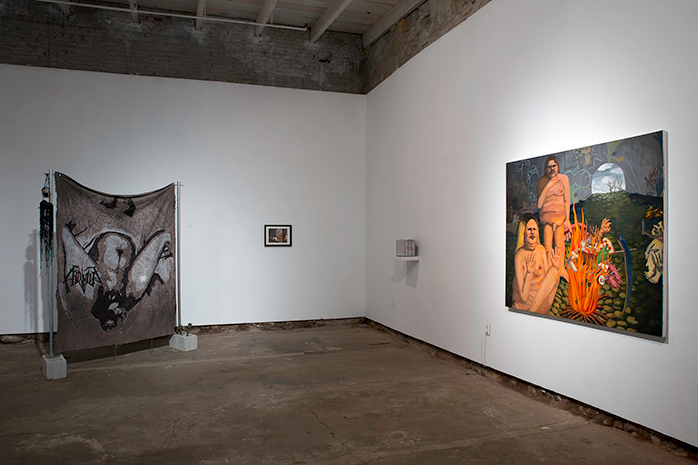“Hard to Please” at Little Berlin
The Form Review is a simple attempt to increase dialogue within art journalism and highlight the subjectivity of a traditional exhibition review. Artists/curators/responsible parties of an exhibition are invited to respond to five short prompts. In turn, a representative of the St.Claire views the exhibition and independently responds to the same five prompts. Both sets of “form answers” are published in tandem on the St.Claire website. To participate drop us a line at hark@the-st-claire.com

(IMAGE: Installation view Hard to Please courtesy of Maddie Hewitt)
 Responses by Maddie Hewitt, Curator
Responses by Maddie Hewitt, Curator
1. What is hidden in this exhibition? What is in plain sight?
In plain sight are groups of people in mid-conflict, and a miniature garden where opposing plant teams serve as placeholders for humans in a similar state. Each artwork represents a relationship between two people at odds. In many ways the origin and resolution of each rivalry is hidden. Although for me, the white elephant in the room is my personal grappling to understand the complexities and (passive) aggressions that exist in interpersonal and working relationships.
2. Who would be this exhibition’s parents? What might it’s children look like?
The mother is a breadwinning powerhouse who works 60+ hours a week, while the father stays at home cooking, cleaning, folding laundry, and scheduling after school carpool dates for their kids who grow up thinking nothing of their family structure. That is until they reach their tween years when they notice other, more conservative family dynamics. At that time the children – two boys – join the wrestling team where they eventually begin injecting steroid hormones to match society’s expectations of masculinity, while combatting their own thoughts and desires to grow out their hair, attend art school and watch porn in a dark basement with their friends.
3. Describe one moment in this exhibition.
When people look at Crowning (Queenie) by Chiara No and realize that the woman depicted is actually crowning: the point in childbirth when a baby’s head fully appears at the vaginal opening. Your pelvis recoils and your face winces as though a baby is escaping out before you onto the concrete floor of the gallery.
4. This exhibition answers/asks the following question:
At the heart of all relationships exists a mutual desire. / Do our mutual desires inevitably pin us against each other?
5. You should message this exhibition if…
in life you believe altercations can lead to empathy, or hope to restore your confidence in that potential.
 Responses by Matt Kalasky, Editor, The S.Claire
Responses by Matt Kalasky, Editor, The S.Claire
1. What is hidden in this exhibition? What is in plain sight?
What I can’t see is a way out. A conflict with no winner and no loser is a conflict with no end. What is apparent is a crisis of stasis: Things cannot possibly stay the way they are now but somehow they do. Endless competition, endless violation, endless endlessness, produces an ugly combination of anguish and acceptance. It is a feeling that has been going around lately.
2. Who would be this exhibition’s parents? What might it’s children look like?
There is this Slavoj Žižek interview where he describes two parental situations set generations apart: In the first, a child will not eat his dinner so the father of a bygone time says, “If you do not eat your dinner I will beat you.” In the second, the modern father responds to the petulant child by saying, “If you do not eat your dinner you will make your mother sad.” Zizek contends they both responses are violent but in different ways and that we would do good to be mindful of the later in our everyday lives.
3. Describe one moment in this exhibition.
The figures in GaHee Park’s paintings are in perpetual public debasement. Someone is always witness to their nakedness—their chubby chubbies–their pepperoni areola. Nudist or neanderthals? I can’t tell with which demographic they identify or if their shame evaporated in grief or in ecstasy. They are descendants of Plato’s cave dwellers who were enslaved eons ago; prisoners held ignorant of the truth. In contrast, the figures of Park’s paintings seem locked in both understanding and resignation of their surroundings. They stay not because they can’t leave but because the cave of horrors is their home and I think you will find that there is a certain comfort in discomfort.
4. This exhibition answers/asks the following question:
How do we leave this conflict behind? Is there even anywhere else to go?
5. You should message this exhibition if…
you understand life is a crushing set of gears and you are cool with that.
…
Hard to Please
Curated by Maddie Hewitt
littleberlin.org/hard-to-please-3/
ON VIEW:
November 7 – November 29, 2014
Little Berlin
2430 Coral St.
Philadelphia, PA 19125
